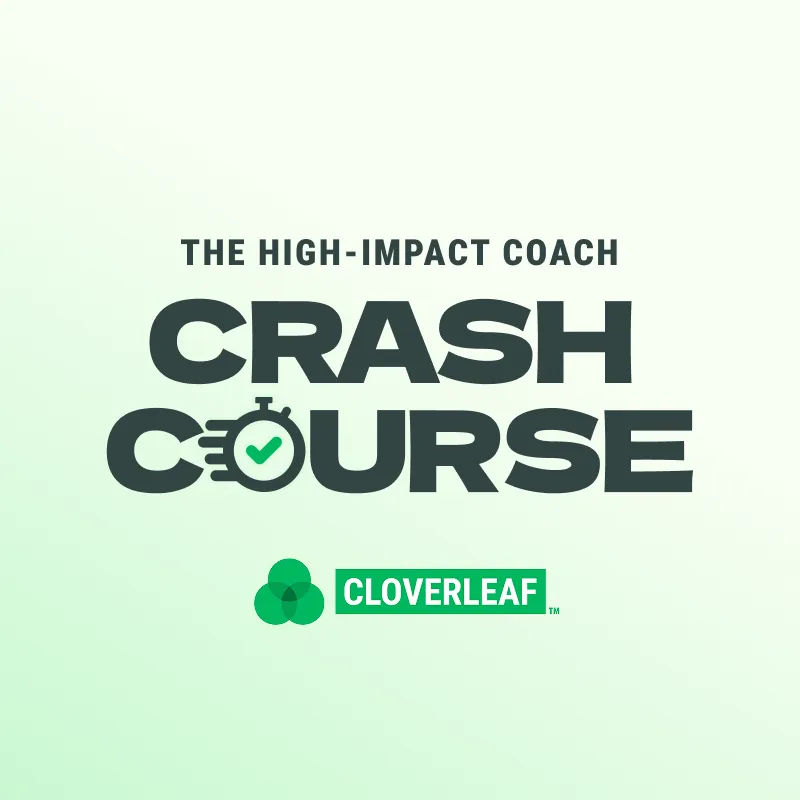Data-Driven Coaching Starts With Insight—But It Has to Lead to Development
Executive coaches today face more pressure than ever:
- Prove the ROI of coaching
- Differentiate in a saturated, credential-heavy market
- Deliver deeper impact—without doubling their hours
In that context, being “data-driven” sounds like the right move. It signals credibility, rigor, and results. But there’s a gap hiding inside most data-driven approaches:
Most “data-driven coaching” strategies only diagnose—but they don’t develop.
You gather assessment results. Maybe you reference them in a debrief. Perhaps you use a few client metrics. But by the next session, the data is forgotten, and the coaching becomes reactive again.
So what does data-driven coaching actually look like?
It’s not about piling up reports. And it’s not about replacing the coach with automation.
It’s about applying insight—continuously, contextually, and in the moments that matter.
Because behavior change is lived out in between sessions, in the meetings, in decisions, in tension with a teammate, that’s where coaching needs to show up.
This article will walk you through a modern model of data-driven coaching that:
- Puts insight to work daily (not just quarterly)
- Helps clients grow between sessions
- Keeps you top of mind—without you needing to be in the room
And most importantly, it does all that without losing your voice or your value.
Get the High Impact Coach Crash Course to see how to build a coaching business that delivers more value, serves more clients, and grows more revenue without burning you out.
What Is Data-Driven Coaching—Really?
Let’s cut through the buzzwords.
Data-driven coaching isn’t about crunching numbers or handing clients a 12-page report they’ll never read again. It’s not spreadsheets, dashboards, or analytics for the sake of appearances.
Data-driven coaching is using assessment insight and ongoing feedback to reinforce growth—intentionally, consistently, and in context.
It starts with strong inputs: assessments like DISC, Enneagram, 16 Types, StrengthsFinder, or cognitive models like HBDI. These tools give you the foundational insight: how a leader communicates, what drives them, and where friction might show up on their team.
But the real power of that data isn’t in the first readout. It’s in what happens after.
What Data-Driven Coaching Isn’t:
- A folder of static reports no one reopens
- A coaching log filled with checkboxes and KPIs
- A replacement for intuition, empathy, or the human element of coaching
How Should Coaches Think About Data Driven Coaching:
- A way to tailor your coaching—with more depth, precision, and relevance
- A way to equip your client to keep growing, even when you’re not there
- A way to turn insight into action when the moment demands it
Data-driven coaching doesn’t just help clients understand themselves—it helps them actively lead their own development between sessions.
Think of it as layered insight plus timely reinforcement.
You’re not just helping a client understand their leadership tendencies. You’re helping them use that understanding when they’re prepping for a tough conversation, feeling reactive, or stuck in decision paralysis.
That’s the difference between informative coaching and transformative coaching.
The Reality Is Static Data Doesn’t Drive Behavior Change
Most coaching engagements begin with good intentions—and a great assessment.
But here’s the pattern that plays out too often:
- The client takes a DISC, Enneagram, or 16 Types assessment.
- You debrief it in session, unpack insights, and spark some meaningful reflection.
- Then… it sits in a PDF.
No follow-up. No reinforcement. No practical application.
And the insight that felt powerful in the moment? It fades. Because behavior doesn’t change through information alone—it changes through repetition, relevance, and reflection.
Where Most Platforms Fall Short
Most assessment platforms are not built to support development. They were built for diagnosis. They give you a starting point, but they don’t help you use the data to sustain your client’s progress.
- ❌ Static reports don’t coach. They inform, then disappear.
- ❌ One-off debriefs don’t drive change. The client understands, but doesn’t always act.
- ❌ All the follow-through falls on the coach. Coaches are expected to carry the insight, reinforce the learning, and stay top of mind, without any support.
Even the best coaching session can’t compete with a high-stakes meeting, a packed inbox, or the pressure of day-to-day decisions.
Data and insights are only as good as the moments they’re used. And most clients don’t remember them when it matters.
That’s why so many coaches feel stuck. They know their assessments are valuable. But there’s no mechanism to keep the insight alive after the call ends.
What’s needed isn’t more data. Coaches need tools to help clients engage with the data they already have—on their own terms, in their preferred tools, and in the moments that shape their behavior.
That’s the shift: from coach-delivered insight to client-led application.
And it’s what separates a one-time debrief from a coaching experience that lasts.
Scale Your Coaching Business Without Adding More Hours

Why Coaches Are Stuck Between Sharing Insights And Application
Most coaching doesn’t fall short because of a weak assessment or a lack of insight.
It stalls in the gaps between sessions.
That’s where your client forgets the insight they swore would change everything.
That’s where the “aha” fades into the background of a packed week.
That’s where leadership habits—built over years—snap back into place.
It’s not always about having more data. It’s about staying present with your clients day in and day out.
But here’s the challenge: staying top of mind shouldn’t require more of your time.
That’s where most executive coaching assessment tools stay stuck. They can deliver powerful insight. But the only way to reinforce its value is to book another session, send another recap, or hope your client re-reads the PDF.
Technology Can Help—If It’s Built the Right Way
Coaches don’t need tech that replaces their work.
They need tools that extend it.
That’s the promise of a data-driven platform like Cloverleaf.
Not dashboards for the sake of dashboards.
Not another admin burden.
How Tech Can Remove The Burden Of Recall To Create Development Momentum
Your clients probably don’t need more content—they need cues.
- Timely nudges that surface in the flow of work
- Reinforcement tied to their challenges, their team, their style
- Context-aware coaching that sounds like you—even when you’re not in the room
Technology can use data to deliver actual coaching, not just more content.
When tools amplify data, without diluting personalization, clients engage more deeply. They act on what they’ve learned. And they continue growing between sessions, not just during them.
How Coaches Can Use Tech To Leverage Assessment Data
If you’re still managing coaching touchpoints with static reports, scattered emails, or a growing stack of assessments, it’s no wonder using data in a meaningful way feels impossible.
Data driven coaching should support a more human-centered model of development. Here’s how it works:
🧩 Layered Assessment Data—All in One Place
Most platforms give you one lens. Perhaps DISC or 16 Types, maybe Enneagram.
Today, tools can integrate multiple assessment data, including MBTI/16 Types, Enneagram, DISC, StrengthsFinder, and more, into a single, unified dashboard.
That means:
- You see clients through more than one dimension
- They understand themselves with greater depth
- You can tailor every conversation, without getting certified in every tool
💬 Coaching Nudges Written by Experts, Delivered with AI
With Cloverleaf, every nudge your client receives is based on validated assessments—but written by real humans. Our content team includes behavioral scientists, psychologists, and assessment specialists.
The tips aren’t AI-generated. They’re AI-curated.
That means:
- You know the guidance is accurate, appropriate, and grounded in real-world coaching
- Clients get consistent nudges in Slack, Outlook, Teams, or email, without needing to log into a new platform
- Insight shows up right before the moment it’s needed—like before a team meeting or performance conversation
In a world full of bots and auto-generated fluff, Cloverleaf keeps coaching human.
📊 Coach Dashboards That Track Engagement (Not Just Activity)
You can’t coach what you can’t see.
Cloverleaf’s dashboards let you:
- Monitor which insights clients engage with
- See trending coaching topics
- Understand how usage connects to growth, not just clicks
It’s not performance surveillance. It’s visibility that helps you support, adapt, and deepen your impact.
🔐 Ethical AI. Transparent Use. Coach-Led Always.
You’re in control of the coaching experience. Cloverleaf exists to reinforce it, not dictate it.
Every tip is written by real coaches, rooted in validated assessments, and delivered using AI to curate.
- No scraping client data.
- No training AI on confidential inputs.
- Full transparency, always.
You stay in control. Your clients stay supported.
And your coaching becomes daily, not just scheduled.
What Data-Driven Coaching Is Like In Real Work
Data-driven coaching isn’t a theory—it’s what Cloverleaf coaches are doing every day. Here’s how it shows up in real engagements:
🔁 Staying Top of Mind—and Getting Invited Back
I’m not sure I’d be as successful without it.
One coach described how they used to rely on strong 90-minute workshops to spark change, but Cloverleaf became the follow-through.
By embedding daily insights into clients’ inboxes, the session’s energy didn’t fade. It compounded.
Clients stayed engaged.
Behavior kept changing.
And the coach kept getting asked back, quarter after quarter.
Cloverleaf keeps the flywheel going. I stay top of mind, not because I follow up—but because my coaching does.
👶 Navigating Maternity Leave With Confidence and Connection
One executive coach worked with a high-performing leader preparing for maternity leave. The leader needed facts, clarity, and support, but her manager’s communication style clashed with hers.
That’s where Cloverleaf came in.
Cloverleaf gave us insights into how she navigates uncertainty—and helped her boss show up better, too.
Even while away, the client received personalized coaching nudges. She returned to a team that felt familiar, aligned, and empathetic—because her coaching never left.
⚡ From Team Tension to Collaborative Breakthrough
In another case, a coach was brought in to help a team struggling with internal conflict. The room was tense. Conversations were charged.
The shift happened when they started talking through Cloverleaf data, not personal judgment.
It immediately depersonalized the conversation.
Understanding each other’s types and tendencies gave the team a new lens—and a shared language. What could’ve been a combative session became a collaborative one.
Why This Matters To Your Business
Data-driven coaching isn’t just about better sessions. It’s about building a business where your insight drives lasting transformation, and clients see the value long after the coaching experience.
📈 Deliver More Value—Without Adding Hours
When the coaching and insight keep showing up in the flow of work, your value compounds, without adding hours.
Clients feel seen. Teams keep growing. And you stay part of the conversation, even when you’re not in the room.
The enhancements Cloverleaf provides—especially when I’m not with my clients—allow me to be more present in their minds.
🔁 Retain Clients Longer
When your coaching creates daily momentum, clients don’t lose steam.
They stay engaged.
They keep growing.
And they keep coming back.
This kind of ongoing development builds trust, loyalty, and longer-term partnerships.
Whether it’s a single leader or a multi-team rollout, ongoing insight builds long-term relationships—and recurring revenue.
🧠 Differentiate in a Crowded Market
Plenty of coaches offer DISC or MBTI.
Few deliver layered, personalized data to connect coaching to real team moments on a daily basis.
That’s your edge.
When coaching becomes part of how a team communicates, aligns, and makes decisions, you’re not just a coach. You’re a strategic asset.
🧩 Build a Business That’s Sustainable and Relational
You didn’t become a coach to be in back-to-back meetings.
You became a coach to create transformation.
With the right tools, you don’t have to choose between deep relationships and steady growth. You can:
- Keep coaching human and high-touch
- Make your insight go further
- And build a practice that delivers lasting impact, not just scheduled sessions
The Future of Coaching Is Using Data To Drive Daily Development
Executive coaches aren’t lacking tools. You’re surrounded by assessments, reports, and platforms promising transformation.
But the real differentiator? How powerfully you’re able to apply the data to guide development and meaningful behavior change.
Coaches need help turning “data-driven coaching” from a buzzword into a daily practice, without losing the human connection that makes their work so important.
That means helping leaders:
- Lead with more awareness
- Communicate with more clarity
- Make decisions that align with who they are and how their team works
Cloverleaf turns assessment data into personalized, in-the-moment coaching nudges—so your impact keeps showing up between sessions, when real growth happens.
If you want to:
- Deliver coaching that reinforces behavior change daily
- Extend the impact of your insight across teams and orgs
- Build a practice rooted in relevance, not just sessions
See how top coaches are transforming insight into action—and building more human, more sustainable coaching businesses.







